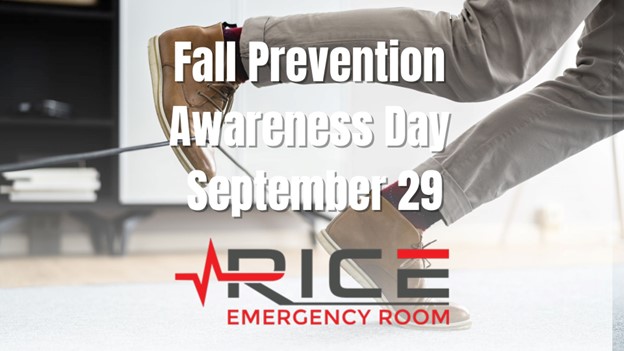Fall Prevention Awareness Day – September 22
September 22nd marks Falls Prevention Awareness Day, an essential day for all, especially our elders. With the onset of the golden autumnal hue, emergency rooms witness an increase in fall-related injuries, particularly among the elderly. Why is this such a prominent concern, and what can we do about it? According to the Centers for Disease Control and Prevention (CDC), 3 million older people are treated in emergency departments for fall injuries every year. Our bones become more brittle as we age, making them more susceptible to fractures. Additionally, age-related issues like vision impairment, muscle weakness, and balance problems make older adults more prone to falls. Let’s explore the causes and fall prevention techniques.
What Factors Lead to Increased Falls in Autumn?
Falls can happen for various reasons, especially as we age. Several factors play a role:
- Slippery Leaves: Wet, fallen leaves can be as slippery as ice.
- Reduced Daylight: Shorter days mean less light, increasing the risk of tripping or slipping.
- Cold Weather: It affects muscle flexibility and joint mobility.
- Health Conditions: Issues like diabetes, heart disease, or thyroid problems can affect the balance.
- Cognitive Issues: Older folks with mild cognitive problems or certain dementias are likelier to trip or slip.
- Sarcopenia: As we age, we might experience muscle loss, balance issues, or sudden blood pressure drops when standing up, making it unsafe. This condition is known as sarcopenia and is common in older adults.
- Footwear & Foot Problems: Believe it or not, painful feet or those snazzy high heels can make us more prone to falls.
- Medications: Some medicines can leave us feeling dizzy or confused; the more we’re on, the higher our risk of a tumble. (National Institute on Aging)
Effective Fall Prevention Strategies
While the statistics may sound daunting, the good news is that many falls are preventable. Let’s delve into the strategies:
- Safety-First Home Environment: From decluttering walkways to securing loose rugs, ensure your living space is free from hazards. Adding grab bars in the bathroom and railings on both sides of stairways can be immensely helpful. Well-lit rooms and hallways can prevent missteps, especially during the shorter daylight hours of autumn.
- Stay Active: Physical activity can go a long way. Regular exercises, even simple ones, can strengthen the lower body and improve balance. Walking, water workouts, or Tai Chi can increase muscle strength, balance, and flexibility.
- Check Your Medications: Some medications or combinations thereof can lead to drowsiness or dizziness. Always discuss your medications with your healthcare provider, and ensure that none increases your fall risk.
- Eyes and Ears Check: Vision and hearing are crucial. With poor vision, you may not see potential floor hazards. Similarly, if your hearing is compromised, you might not hear someone cautioning you. Regular check-ups are essential.
- Footwear Fundamentals: The right shoes can provide the necessary support. Non-slip soles are ideal, especially during wet autumn months. While wearing those trendy high heels or smooth-soled shoes might be tempting, opt for safer, more supportive footwear.
- Vitamin D Supplementation for Deficiency: Supplementing vitamin D is crucial for individuals with deficiency or a high risk of falls. Adequate vitamin D levels enhance bone health, reducing fracture risk. Moreover, it aids in muscle strength and balance, lowering the likelihood of falls, especially among older adults, and promoting overall well-being. (Lee et al.)
When to go to the ER?
It would be best to go to the ER when there’s a severe head injury with symptoms like passing out, headaches, confusion, or head bleeding. It is also crucial to visit for broken bones due to intense pain, swelling, or deformity. Deep cuts needing stitches, loss of consciousness, severe chest or belly pain, or sudden neurological problems like weakness or vision changes require immediate attention, too. (EmergencyPhysicians.org)
A Holistic Approach
Preventing falls isn’t just an individual or family responsibility; it’s a community effort. Whether it’s local community centers offering exercise classes tailored for seniors or neighborhoods ensuring public paths are clear of fall hazards, there’s a role for everyone. While the physical aspects of fall prevention are often emphasized, let’s remember the mental and emotional facets. A previous fall can instill fear, leading to decreased activity. Talk about it. Engaging in conversations, joining support groups, or seeking counseling can help address these fears, ensuring a holistic approach to well-being. (Myers et al.)
Falls, particularly in older adults, are a significant concern. However, with awareness, proactive strategies, and community involvement, falls and related injuries can be significantly reduced. Remember, prevention is always better than cure. Let’s make this autumn safe for everyone!
Works Cited
Centers for Disease Control and Prevention. “Facts about Falls.” Centers for Disease Control and Prevention, 12 May 2023,
National Institute on Aging. “Falls and Fractures in Older Adults: Causes and Prevention.” National Institute on Aging, U.S. Department of Health and Human Services,
www.nia.nih.gov/health/falls-and-fractures-older-adults-causes-and-prevention.
Lee, Aimee, et al. “Preventing Falls in the Geriatric Population.” The Permanente Journal, U.S. National Library of Medicine, 2013,
www.ncbi.nlm.nih.gov/pmc/articles/PMC3854807/.
EmergencyPhysicians.org. “Head Injury – Know When to Go to the ER.” – Know When to Go to the ER,
www.emergencyphysicians.org/article/know-when-to-go/head-injury.
Myers, Wyatt, et al. “How to Prevent Falls at Home.” EverydayHealth.Com, www.everydayhealth.com/longevity/future-planning/prevent-falls-at-home.aspx.
 24x7 Available
24x7 Available

